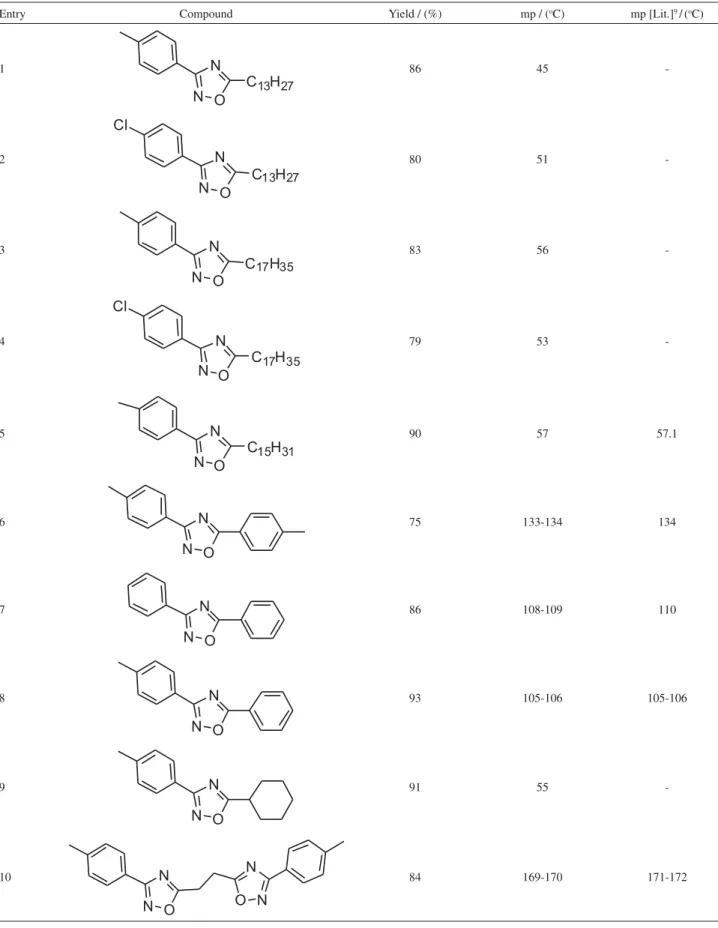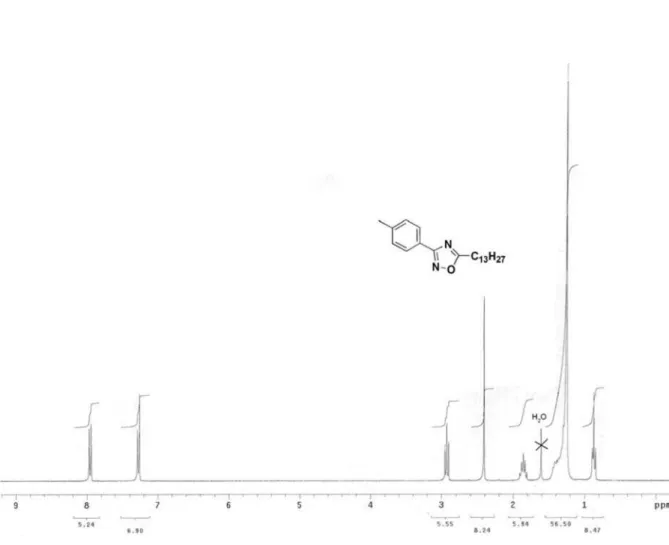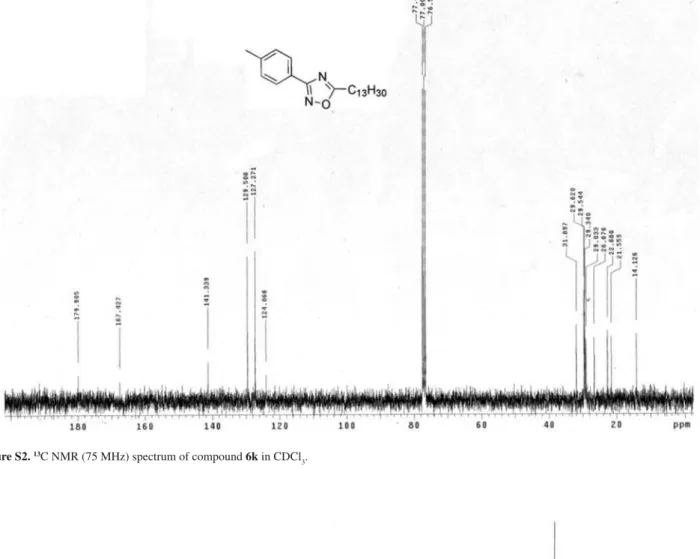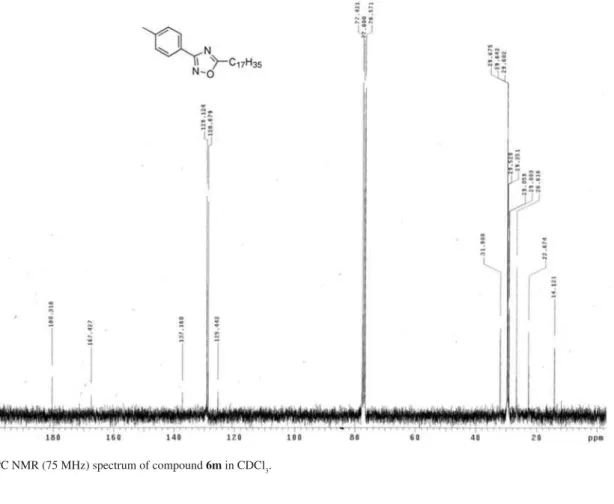A
rti
c
le
J. Braz. Chem. Soc., Vol. 20, No. 7, 1365-1369, 2009. Printed in Brazil - ©2009 Sociedade Brasileira de Química 0103 - 5053 $6.00+0.00
*e-mail: rms_indu@yahoo.com
#Taken in part from the MSc Dissertation (2007) of Natércia M. M. Bezerra, Universidade Federal de Pernambuco, Recife-PE, Brazil
An Easy Synthesis of 3,5-Disubstituted 1,2,4-Oxadiazoles from Carboxylic Acids
and Arylamidoximes Mediated by Ethyl Chloroformate
Ricardo A. W. Neves Filho, Natércia M. M. Bezerra,
#José M. Guedes and Rajendra M. Srivastava*
Departamento de Química Fundamental, Universidade Federal de Pernambuco, Cidade Universitária, 50740-540 Recife-PE, Brazil
Uma síntese limpa, fácil e eficiente de vários 1,2,4-oxadiazóis 3,5-dissubstituídos partindo de um anidrido misto (gerado a partir de um ácido carboxílico e cloroformiato de etila) e amidoxima é descrita.
An efficient, clean and easy high-yielding synthesis of 3,5-disubstituted 1,2,4-oxadiazoles starting from mixed anhydrides (generated from carboxylic acids and ethyl chloroformate) and arylamidoximes is described.
Keywords: carboxylic acids, arylamidoximes, 1,2,4-oxadiazoles, 1H and 13C NMR spectra
Introduction
1,2,4-Oxadiazoles are well-known nitrogen compounds and sizeable work has been done in this area since their first preparation in 1884.1 A recent review covering the research papers published from 1996 through 2007 describes the interesting synthetic developments of 1,2,4- and 1,3,4-oxadiazoles.2 This review also quotes the already established biological attributes to this class of compounds. Although much attention has been given for pharmacological evaluations of 1,2,4-oxadiazoles, recent publications showed also their applicability in the field of luminescent liquid crystals, materials for optical devices, and charge-transporters for organic light-emitting diodes (OLEDs).3 Because of the vast importance of this class of compounds,3 which is constantly growing,4 we decided to develop their simpler and less time-consuming synthesis.
The most prevalent method for synthesizing 1,2,4-oxadiazoles involves O-acylation of amidoximes followed by cyclodehydratation. Acyl chlorides, anhydrides, esteres, and trichloroalkanes are commonly used as acylating agents.5 Carboxylic acids in the presence of coupling reagents like DCC, DIC or EDC are also employed to achieve the same goal.5,6 These procedures need much work to purify the desired 1,2,4-oxadiazoles. Besides
undesired side products are also formed which require, additional time and efforts for their separation.
One-pot methodologies for organic synthesis have attracted chemists’ and pharmacists’ interest from industries and academia, because these procedures allow reaching the target compounds without isolation of synthetic intermediates.7 In addition, one-pot reactions also reduce the use of solvents, reagents and adsorbents commonly employed for purifying the intermediates, being considered green protocols.7 Therefore, we have focused our attention in developing a clean one-pot protocol which allows the synthesis of 1,2,4-oxadiazoles in good yields with less work-up and avoids side product formation. Herein, we would like to report, for the first time, the synthesis of some 2,5-disubstituted 1,2,4-oxadiazoles from carboxylic acids and arylamidoximes in the presence of ethyl chloroformate as a coupling agent (Scheme 1 and Table 1).
Results and Discussion
An Easy Synthesis of 3,5-Disubstituted 1,2,4-oxadiazoles from Carboxylic Acids J. Braz. Chem. Soc. 1366
or Et3N as bases. We chose to use potassium carbonate because it is cheap as well as easy to remove after the reaction. Thus, a suitable carboxylic acid 1a-g was stirred in the presence of K2CO3 in CH2Cl2 for 30 min to achieve the formation of carboxylic acid potassium salt which reacts with ethyl chloroformate 2 to generate in situ the mixed anhydrides 3a-g. Then, an appropriate amidoxime 4h-j was added to the same solution followed by stirring for an additional 2 h. The reaction between 3a-g and 4h-j formsO-acylamidoximes 5k-twith the liberation of CO2 and EtOH. Although the intermediates 5k-t can be isolated and characterized, we avoided their isolation in many cases. In fact, these were cyclodehydrated individually to afford 1,2,4-oxadiazoles (Table 1).
In order to verify the structure of the intermediates 5k-t, we have isolated two known products 5p and 5q whose physical and chemical properties agreed with the literature.10 Once the structures of the above-cited intermediates have been established, we proceeded to obtain the final products in excellent yields (75-93%). This general protocol has worked well with aromatic, aliphatic and carbocyclic carboxylic acids (entries 1-10, Table 1). Compounds 5k-o,t are new ones and their structures have been confirmed by, IR, 1H and 13C NMR spectra and elemental analyses. The known
compounds 5p-r,s were characterized by comparing their reported melting points and spectral data.9
Conclusions
In summary, we have developed an alternate new method to synthesize 1,2,4-oxadiazoles from carboxylic acids and arylamidoximes using ethyl chloroformate as a coupling agent. The desired 3,5-disubstituted oxadiazoles 6k-t have been obtained in excellent yields after simple work-up. This protocol is applicable for synthesizing 1,2,4-oxadiazoles containing aryl or alkyl groups attached at their C-5 side-chain. Further, this procedure is also suitable for the obtaining bis-1,2,4-oxadiazoles.
Experimental
General experimental procedures
All reagents were obtained from commercial sources and used without further purification. Infrared spectra were recorded on a Perkin-Elmer model 283 spectrometer in KBr discs. 1H and 13C NMR spectra of CDCl
3 solutions were obtained in a Varian 300-MHz instrument using Scheme 1. R O OH Cl O OEt
K2CO3
CH2Cl2, r.t.
R O
O O
OEt K
2CO3
CH2Cl2, r.t.
Ar NH2 N Ar NH2 N
120oC
4h N N O Ar R a: C13H27
b: C17H35 c: C15H31
d: C6H5
e: 4-CH3C6H4 f: C6H11
g:
1a-g
N O N
CH2CH2 2
3a-g
4h-j
k: R = C13H27, Ar = 4-CH3C6H4
l: R = C13H27, Ar = 4-ClC6H4 m: R = C17H35, Ar = 4-CH3C6H4
n: R = C17H35, Ar = 4-ClC6H4 o: R = C15H31, Ar = 4-CH3C6H4 p: R = 4-CH3C6H4, Ar = 4-CH3C6H4
q: R = C6H5, Ar = C6H5 r: R = C6H5, Ar = 4-CH3C6H4
s: R= C6H11, Ar = 4-CH3C6H4
N O N
CH2CH2
R=
Ar = 4-CH3C6H4
5k-t
6k-t
t:
OH
R
h: C6H5
i: 4-CH3C6H4
j: 4-ClC6H4
Ar
Dry heating
O R
Neves Filho et al. 1367 Vol. 20, No. 7, 2009
Table 1. Synthesis of 3,5-disubstituted 1,2,4-oxadiazoles 6k-t
Entry Compound Yield / (%) mp / (oC) mp [Lit.]9/ (oC)
1 86 45
-2 80 51
-3 83 56
-4 79 53
-5 90 57 57.1
6 75 133-134 134
7 86 108-109 110
8 93 105-106 105-106
9 91 55
An Easy Synthesis of 3,5-Disubstituted 1,2,4-oxadiazoles from Carboxylic Acids J. Braz. Chem. Soc. 1368
tetramethylsilane (TMS) as the internal standard. Elemental analysis was performed with a Carlo Erba instrument model E-1110. Carboxylic acids 1a-f were obtained from commercial sources while 1g and arylamidoximes 4h-j were prepared following the procedures reported earlier.9,11
Typical experimental procedure
A suitable carboxylic acid 1a-f (1.6 mmol) was dissolved in dry CH2Cl2(8.0 mL) and placed in a round bottom flask followed by the addition of K2CO3(0.33g, 2.4 mmol) under stirring and kept as such for 30 min at room temperature. Later, ethyl chloroformate 2 (0.2 mL, 2.4 mmol) was added to the same flask and stirred for an additional 30 min. Finally, the addition of an appropriate amidoxime 4h-j (1.6 mmol) with continuous agitation for 2 h completed the reaction. Filtration and solvent evaporation under reduced pressure furnished the crude product which upon heating in an oil bath at 120 oC for 4 h gave the desired compounds which were crystallized from EtOH.
3-(4-Tolyl)-5-tridecanyl-1,2,4-oxadiazole (6k)
Yield: 86%; colorless crystals; mp 45 °C; Rf 0.61 (CHCl3:C6H12, 1:1). IR (KBr) ν
max/cm
-1: 3049, 2922, 2926,
2846, 1576. 1H NMR (300 MHz,CDCl
3);G 0.87 (t, J7.5 Hz, 3H), 1.25-1.48 (bs, 22H ), 1.86 (quintet, J 7.5 Hz, 2H), 2.93 (t, J7.5 Hz, 2H), 2.41 (s, 3H), 7.23 (d, J8.4 Hz, 2H), 7.96 (d, J 8.4 Hz, 2H).13C NMR (75 MHz,CDCl
3); G14.13, 21.56, 22.68, 26.67, 29.03, 29.34, 29.54, 29.62, 31.90, 124.07, 127.27, 129.51, 141.34, 168.51, 179.91. Anal. Calc. for C22H36N2O C, 76.69; H, 10.53; N, 8.13. Found: C, 76.43; H, 10.98; N, 8.21.
3-(4-Chlorophenyl)-5-tridecanyl-1,2,4-oxadiazole (6l) Yield: 80%; colorlerss crystals; mp 51 °C; Rf 0.62 (CHCl3:C6H12, 1:1). IR (KBr) ν
max/cm
-1: 3049; 2920;
2925; 2843; 1572; 1H NMR (300 MHz, CDCl
3);G 0.88 (t,
J7.2 Hz, 3H), 1.25-1.49 (bs, 22H ), 1.86 (quintet, J7.8 Hz, 2H), 2.93 (t, J7.5 Hz, 2H), 7.45 (d, J8.4 Hz, 2H), 8.01 (d, J8.7 Hz, 2H).13C NMR (75 MHz,CDCl
3);G 14.1, 22.7, 26.6, 29.0, 29.1, 29.3, 29.5, 29.6, 29.65, 29.68, 31.9, 125.4, 128.7, 129.1, 137.2, 167.4, 180.3. Anal. Calc. for C21H33ClN2O C, 69.11; H, 9.11; N, 7.68. Found: C, 69.21; H, 9.54; N, 7.58.
5-Heptadecanyl-3-p-tolyl-1,2,4-oxadiazole (6m)
Yield: 83%; colorless crystals; mp 56 °C; Rf 0.60 (CHCl3:C6H12, 1:1). IR (KBr) ν
max/cm
-1: 3049, 2921, 2846,
1576.1H NMR (300 MHz,CDCl
3)G 0.87 (t, J5.4 Hz, 3H), 1.25-1.50 (bs, 28H ), 1.86 (quintet, J6.9 Hz, 2H), 2.41 (s,
3H), 2.93 (t, J6.9 Hz, 2H), 7.23 (d, J8.1 Hz, 2H), 7.96 (d, J 8.1 Hz, 2H).13C NMR (75 MHz, CDCl
3);G 14.1, 22.7, 26.7, 29.0, 29.3, 29.5, 29.6, 31.9, 125.4, 128.7, 129.1, 137.2, 167.4, 180.3. Anal. Calc. for C26H42N2O C, 78.34; H, 10.62; N, 7.03. Found: C, 78.68; H, 10.58, N, 7.21%.
3-(4-Chlorophenyl)-5-heptadecanyl-1,2,4-oxadiazole (6n)
Yield: 79%; colorless crystals; mp 53 °C; Rf 0.53. (CHCl3:C6H12, 1:1). IR (KBr) ν
max/cm
-1: 3048, 2925,
2925, 2847, 1574. 1H NMR (300 MHz, CDCl
3) G 0.88 (t,J6.6 Hz, 3H), 1.25-1.50 (bs, 28H ), 1.86 (quintet, J8.1 Hz, 2H), 2.94 (t, J8.1 Hz, 2H), 7.45 (d, J 8.7 Hz, 2H), 8.01 (d, J8.7 Hz, 2H).13C NMR (75 MHz,CDCl
3);G 14.1, 22.7, 26.6, 29.0, 29.1, 29.3, 29.5, 29.6, 29.64, 29.67, 31.9, 125.4, 128.7, 129.1, 137.2, 167.4, 180.3. Anal. Calc. for C25H39ClN2O C, 71.66; H, 9.38; N, 6.69. Found: C, 72.01; H, 9.47; N, 6.98%.
5-Pentadecanyl-3-p-tolyl-1,2,4-oxadiazole (6o)
Yield: 90%; colorless crystals; mp 57 °C (lit,9 mp 57.1 °C); Rf 0.51 (CHCl3:C6H12, 1:1). IR (KBr) ν
max/cm -1:
3063, 2954, 2917, 2848, 1588. 1H NMR (300 MHz, CDCl 3);
G 0.88 (t, J 6.9 Hz, 3H), 1.25-1.44 (bs, 24H ), 1.86 (quintet, J 7.8 Hz, 2H), 2.41 (s, 3H), 2.93 (t, J7.8 Hz, 2H), 7.23 (d, J8.1 Hz, 2H), 7.95 (d, J8.1 Hz, 2H).
3,5-Di-p-tolyl-1,2,4-oxadiazole (6p)
Yield: 75%; colorless crystals; mp 133 °C (lit,9mp 134 °C); Rf 0.72 (CHCl3). IR (KBr) ν
max/cm
-1: 3023, 2920, 2850,
1594.1H NMR (300 MHz, CDCl
3);G 2.39 and 2.40 (2s, 6H), 7.27 (d, J7.6 Hz, 2H, ), 7.28 (d, J7.8 Hz, 2H), 8.05 (d,J 7.8 Hz, 2H, ), 8.06 (d, J7.6 Hz, 2H).
3,5-Diphenyl-1,2,4-oxadiazole (6q)
Yield: 86%; colorless crystals; mp 108-109 °C (lit.9 mp 110 °C); Rf 0.70 (CHCl3). IR (KBr) ν
max/cm
-1: 3022, 2920,
2839, 1594. 1H NMR (300 MHz, CDCl
3);G 7.51-7.62 (m, 6H), 8.14-8.25 (m, 4H).
3-Phenyl-3-p-tolyl-1,2,4-oxadiazole (6r)
Yield: 93%; colorless crystals; mp 105-106 °C (lit,9 mp 105-106 °C); Rf 0.52 (CHCl3/C6H12, 1:1). IR (KBr) ν
max/cm -1:
3049, 2955, 2915, 1560. 1H NMR (300 MHz, CDCl 3);G 2.44 (s, 3H), 7.32 (d, J9.6 Hz, 2H), 7.55-7.60 (m, 3H), 8.07 (d, J8.7 Hz, 2H), 8.22 (d, J9.6 Hz, 2H).
5-Cyclohexyl-4-p-tolyl-1,2,4-oxadiazole (6s)
Yield: 91%; colorless crystals; mp 55 °C; Rf 0.80 (CHCl3). IR (KBr) ν
max/cm
-1: 3035, 2918, 2852, 1589.1H
Neves Filho et al. 1369 Vol. 20, No. 7, 2009
3H), 3.00 (tt, J
ax-ax 11.1 Hz, Jax-eq 3.6 Hz, 1H), 7.27 (d, J 8.4
Hz, 2H), 7.96 (d, J 8.4 Hz, 2H). 13C NMR (75 MHz, CDCl 3);
G 21.5, 25.3, 25.5, 30.2, 36.3, 124.2, 127.3, 129.4, 141.2, 168.0, 182.7. Anal. Calc. for C15H18N2O C, 74.35; H, 7.49; N, 11.56. Found: C, 74.48; H, 7.33; N, 11.62.
1,2-Bis-(3-p-tolyl-1,2,4-oxadiazol-5-yl)ethane (6t) Yield: 84%; colorless crystals; mp 169-170 °C (lit.9 mp 171-172 °C); Rf 0.73 (CHCl3). IR (KBr) ν
max/cm -1:
3032, 2926, 2854, 1590. 1H NMR (300 MHz, CDCl 3);G 2.41 (s, 6H), 3.57 (s, 4H), 7.28 (d, J 8.4 Hz, 4H), 7.95 (d, J 8.4 Hz, 4H).
Acknowledgments
The authors are grateful to the Brazilian National Research Council (CNPq) for financial support. One of us N.M.M.B. is thankful to Coordination for the Improvement of Higher Education Staff (CAPES) for a MSc fellowship.
Supplementary Information
Detailed experimental procedures and full set of 1H and 13C NMR spectra are available free of charge at
http://jbcs.sbq.org.br, as a PDF file.
References
1. Tiemann, F.; Krüger, P.; Tiemann, F.; Krüger, P.; Ber.Dtsch. Chem. Ges.1884,17, 1685.
2. Jakopin, Z.; Dolenc, M. S.; Curr. Org. Chem.2008,12, 850. 3. Torgova, S. I.; Karamysheva, L. A.; Strigazzi, A.; Braz. J.
Phys.2002,32, 593; Gallardo, H.; Cristiano, R.; Vieira, A. A.; Neves Filho, R. A. W.; Srivastava, R. M.; Synthesis2008, 605; Gallardo, H.; Cristiano, R.; Vieira, A. A.; Neves Filho, R. A. W.; Srivastava, R. M.; Bechtold, I. H.; Liq. Cryst. 2008,35, 857; Kawamonzen, Y.; Nakayama, T.; Jpn. Kokai Tokkyo Koho
2004, 51; Taguchi, T.; Jpn. Kokai Tokkyo Koho2000, 11. 4. Rovner, S.; C&EN2007,85, 17; Jarvis, L. M.; C&EN2008,
86, 15.
5. Kaboudin, B.; Saadati, F.; J. Heterocycl. Chem. 2005, 42, 699; Srivastava, R. M.; Seabra, G. M.; J. Braz. Chem. Soc.
1997,8, 397; de Freitas, J. J. R.; de Freitas, J. C. R.; da Silva, L. P.; de Freitas Filho, J. R.; Kimura, G. Y. V.; Srivastava,
R. M.; Tetrahedron Lett. 2007, 48, 6195; Belen’kii, L. I.; Brokhovetskii, D. B.; Krayushkin, M. M.; Tetrahedron 1990,
46, 1659; Denney, D. B.; Feig, G.; J. Am. Chem. Soc.1959,81,
225.
6. Katritzky, A. R.; Shestopalov, A. A.; Suzuki, K.; ARKIVOK
2005, 7, 36 and references cited therein; Braga, V. M. L.; Melo, S. J.; Srivastava, R. M.; Falcão, E. P. S.; J. Braz.Chem. Soc.2004,15, 603; Melo, S. J.; Sobral, A. D.; Lopes, H. L.; Srivastava, R. M.; J. Braz.Chem. Soc. 1998,9, 465.
7. Pervin, G.; Jacob, R. G.; Bottselle, G. V.; Kublik, E. L.; Lenardão, E. J.; Cella, R.; Santos, P. C. S.; J. Braz. Chem. Soc.
2005,16, 857; Bonacorso, A. G.; Oliveira, M. R.; Costa, M. B.; Silva, L. B.; Zanatta, N.; Martins, M. A. P.; Flores, A. F. C.;J. Braz.Chem. Soc. 2005,16, 868; Lenardão, E. J.; Freitag, R. A.; Dabdoub, J. M.; Batista, A. C. F.; Silveira, C. C.; Quim. Nova2003,26, 123.
8. Nakamura, T.; Noguchi, T.; Miyachi, H.; Hashimoto, Y.; Chem. Pharm. Bull.2007,55, 651; Jarho, E. M.; Venaelaeinen, J. I.; Poutiainen, S.; Leskinen, H.; Vepsaelaeinen, J.; Christiaans, J. A. M.; Forsberg, M. M.; Maennistoe, P. T.; Wallen, E. A. A.; Bioorg. Med. Chem. 2007, 15, 2024; Hargaden, G. C.; Muller-Bunz, H.; Guiry, P. J.; Eur. J. Org. Chem.2007,25, 4235; Kikuchi, M.; Inagaki, T.; Nishiyama, H.; Synlett2007,
7, 1075; Almasi, D.; Alonso, D. A.; Gomez-Bengoa, E.; Nagel, Y.; Najera, C.; Eur. J. Org. Chem.2007,14, 2328.
9. For compounds 6o-rsee: Bezerra, N. M. M.; Oliveira, S. P.; Srivastava, R. M.; da Silva, J. R.; Il Farmaco2005,60, 955; Leite, L. F. C.; Srivastava, R. M.; Cavalcanti, A. P.; Bull. Soc. Chim. Belges1989,98, 203; Goetz, N.; Synthesis1976, 268; Chiou, S.; J. Heterocycl. Chem. 1989,26, 125; For compound
6t see: Srivastava, R. M.; da Silva, A. J. C. N.; de Oliveira, M.
L.;J. Braz. Chem. Soc.1993,4, 84.
10. For compound 5p see Foti, F.; Grassi, G.; Resitiano, F.; Caruso, F.; J. Chem. Res. 1982,11, 302; For compound 5ssee Kawashima, E.; Ando, Y.; Tubei, K.; Miyamae, H.; Heterocycles
1987,26, 1015.
11. Srivastava, R. M.; Brinn, I. M.; Machuca-Herrera, J. O.; Faria, H. B.; Carpenter, G. B.; Venkatesh, C. G.; de Morais, L. P. F.;
J. Mol. Struct.1997,406, 159.
S
u
p
p
le
m
e
nta
ry
Inf
o
rm
a
ti
o
n
J. Braz. Chem. Soc., Vol. 20, No. 7, S1-S10, 2009. Printed in Brazil - ©2009 Sociedade Brasileira de Química 0103 - 5053 $6.00+0.00
*e-mail: rms_indu@yahoo.com
#Taken in part from the M. Sc. Dissertation (2007) of Natércia M. M. Bezerra, Universidade Federal de Pernambuco, Recife, PE, Brazil
An Easy Synthesis of 3,5-Disubstituted 1,2,4-oxadiazoles from Carboxylic Acids and
Arylamidoximes Mediated by Ethyl Chloroformate
Ricardo A. W. Neves Filho, Natércia M. M. Bezerra,
#José M. Guedes and Rajendra M. Srivastava*
Departamento de Química Fundamental, Universidade Federal de Pernambuco, Cidade Universitária, 50740-540 Recife-PE, Brazil
Experimental
General experimental procedures
All reagents were obtained from commercial sources and used without further purification. Infrared spectra were recorded on a Perkin-Elmer model 283 spectrometer in KBr discs. 1H and 13C NMR spectra of CDCl
3 solutions were obtained in a Varian 300-MHz instrument using tetramethylsilane (TMS) as the internal standard. Elemental analysis was performed with a Carlo Erba instrument model E-1110. Carboxylic acids 1a-f were obtained from commercial sources while 1g and arylamidoximes 4h-j were prepared following the procedure reported earlier.1,2
Typical experimental procedure
A suitable carboxylic acid 1a-f (1.6 mmol) was dissolved in dry CH2Cl2 (8.0 mL) and placed in a round bottom flask followed by the addition of K2CO3 (0.332g, 2.4 mmol) under stirring and kept as such for 30 min at room temperature. Later ethyl chloroformate 2 (0.2 mL, 2.4 mmol) was added to the same flask and stirred for an additional 30 min. Finally, the addition of an appropriate amidoxime 4h-j (1.6 mmol) with continuous agitation for 2h completed the reaction. Filtration and solvent evaporation under reduced pressure furnished the crude product which upon heating in an oil bath at 120 oC for 4h gave the desired compounds which were crystallized from EtOH.
3-(4-Tolyl)-5-tridecanyl-1,2,4-oxadiazole (6k)
Yield: 86%; colorless crystals; mp 45 °C; Rf 0.61 (CHCl3:C6H12, 1:1). IR (KBr) ν
max/cm
-1: 3049, 2922, 2926,
2846, 1576. 1H NMR (300 MHz, CDCl
3);G 0.87 (t, J7.5 Hz, 3H), 1.25-1.48 (bs, 22H ), 1.86 (quintet, J 7.5 Hz, 2H), 2.93 (t, J7.5 Hz, 2H), 2.41 (s, 3H), 7.23 (d, J8.4 Hz, 2H), 7.96 (d, J8.4 Hz, 2H).13C NMR (75 MHz, CDCl
3);
G 14.13, 21.56, 22.68, 26.67, 29.03, 29.34, 29.54, 29.62, 31.90, 124.07, 127.27, 129.51, 141.34, 168.51, 179.91. Anal. Calc. for C22H36N2O C, 76.69; H, 10.53; N, 8.13. Found: C, 76.43; H, 10.98; N, 8.21.
3-(4-Chlorophenyl)-5- tridecanyl-1,2,4-oxadiazole (6l)
Yield: 80%; colorless crystals; mp 51 °C; Rf 0.62 (CHCl3:C6H12, 1:1). IR (KBr) ν
max/cm
-1: 3049; 2920; 2925;
2843; 1572; 1H NMR (300 MHz,CDCl
3);G 0.88 (t, J7.2 Hz, 3H), 1.25-1.49 (bs, 22H ), 1.86 (quintet, J 7.8 Hz, 2H), 2.93 (t, J7.5 Hz, 2H), 7.45 (d, J8.4 Hz, 2H), 8.01 (d, J 8.7 Hz, 2H).13C NMR (75 MHz, CDCl
3); G 14.1, 22.7, 26.6, 29.0, 29.1, 29.3, 29.5, 29.6, 29.65, 29.68, 31.9, 125.4, 128.7, 129.1, 137.2, 167.4, 180.3. Anal. Calc. for C21H33ClN2O C, 69.11; H, 9.11; N, 7.68. Found: C, 69.21; H, 9.54; N, 7.58.
5-Heptadecanyl-3-p-tolyl-1,2,4-oxadiazole (6m)
Yield: 83%; colorless crystals; mp 56 °C; Rf 0.60 (CHCl3:C6H12, 1:1). IR (KBr) ν
max/cm
-1: 3049, 2921, 2846,
1576.1H NMR (300 MHz, CDCl
An Easy Synthesis of 3,5-Disubstituted 1,2,4-oxadiazoles from Carboxylic Acids J. Braz. Chem. Soc. S2
3H), 2.93 (t, J6.9 Hz, 2H), 7.23 (d, J8.1 Hz, 2H), 7.96 (d, J8.1 Hz, 2H).13C NMR (75 MHz, CDCl
3);G 14.1, 22.7, 26.7, 29.0, 29.3, 29.5, 29.6, 31.9, 125.4, 128.7, 129.1, 137.2, 167.4, 180.3. Anal. Calc. for C26H42N2O C, 78.34; H, 10.62; N, 7.03; Found: C, 78.68; H, 10.58, N, 7.21%.
3-(4-Chlorophenyl)-5-heptadecanyl-1,2,4-oxadiazole (6n)
Yield: 79%; colorless crystals; mp 53 °C; Rf 0.53. (CHCl3:C6H12, 1:1). IR (KBr) ν
max/cm
-1: 3048, 2925, 2925,
2847, 1574. 1H NMR (300 MHz, CDCl
3) G 8.01 (d, J 8.7 Hz, 2H), 7.45 (d, J 8.7 Hz, 2H), 2.94 (t, J8.1 Hz, 2H), 1.86 (quintet,J 8.1 Hz, 2H), 1.25 (m, 28H ), 0.88 (t, J 6.6 Hz, 3H).13C NMR (75 MHz, CDCl
3);G 14.1, 22.7, 26.6, 29.0, 29.1, 29.3, 29.5, 29.6, 29.64, 29.67, 31.9, 125.4, 128.7, 129.1, 137.2, 167.4, 180.3. Anal. Calc. for C25H39ClN2O C, 71.66; H, 9.38; N, 6.69. Found: C, 72.01; H, 9.47; N, 6.98%.
5-Pentadecanyl-3-p-tolyl-1,2,4-oxadiazole (6o)
Yield: 90%; colorless crystals; mp 57 °C (lit,2 mp 57.1 °C); Rf 0.51 (CHCl3:C6H12, 1:1). IR (KBr) ν
max/cm -1:
3063, 2954, 2917, 2848, 1588. 1H NMR (300 MHz, CDCl 3);
G 0.88 (t, J 6.9 Hz, 3H), 1.25-1.44 (bs, 24H ), 1.86 (quintet, J7.8 Hz, 2H), 2.41 (s, 3H), 2.93 (t, J7.8 Hz, 2H), 7.23 (d, J8.1 Hz, 2H), 7.95 (d, J8.1 Hz, 2H).
3,5-Di-p-tolyl-1,2,4-oxadiazole (6p)
Yield: 75%; colorless crystals; mp 133 °C (lit,2mp 134 °C); Rf 0.72 (CHCl3). IR (KBr) ν
max/cm
-1: 3023, 2920, 2850,
1594.1H NMR (300 MHz, CDCl
3);G 2.39 and 2.40 (2s, 6H), 7.27 (d, J7.6 Hz, 2H, ), 7.28 (d, J7.8 Hz, 2H, ), 8.05 (d,J7.8 Hz, 2H, ), 8.06 (d, J7.6 Hz, 2H, ).
3,5-Diphenyl-1,2,4-oxadiazole (6q)
Yield: 86%; colorless crystals; mp 108-109 °C (lit.2 mp 110 °C); Rf 0.70 (CHCl3). IR (KBr) ν
max/cm
-1: 3022, 2920,
2839, 1594. 1H NMR (300 MHz, CDCl
3);G 7.51-7.62 (m, 6H), 8.14-8.25 (m, 4H).
3-Phenyl-3-p-tolyl-1,2,4-oxadiazole (6r)
Yield: 93%; colorless crystals; mp 105-106 °C (lit,2 mp 105-106 °C); Rf 0.52 (CHCl3/C6H12, 1:1). IR (KBr) ν
max/cm -1:
3049, 2955, 2915, 1560. 1H NMR (300 MHz, CDCl 3);
G 2.44 (s, 3H), 7.32 (d, J9.6 Hz, 2H), 7.55-7.60 (m, 3H), 8.07 (d, J8.7 Hz, 2H), 8.22 (d, J9.6 Hz, 2H).
5-Cyclohexyl-4-p-tolyl-1,2,4-oxadiazole (6s)
Yield: 91%; colorless crystals; mp 55 °C; Rf 0.80 (CHCl3). IR (KBr) ν
max/cm
-1: 3035, 2918, 2852, 1589. 1H
NMR (300 MHz, CDCl3);G 1.25-2.15 (m, 10H) , 2.41 (s, 3H), 3.00 (tt, J
ax-ax 11.1 Hz, Jax-eq 3.6 Hz, 1H), 7.27 (d, J 8.4
Hz, 2H), 7.96 (d, J 8.4 Hz, 2H). 13C NMR (75 MHz, CDCl 3);
G 21.5, 25.3, 25.5, 30.2, 36.3, 124.2, 127.3, 129.4, 141.2, 168.0, 182.7. Anal. Calc. for C15H18N2O C, 74.35; H, 7.49; N, 11.56; Found: C, 74.48; H, 7.33; N, 11.62.
1,2-bis(3-p-tolyl-1,2,4-oxadiazol-5-yl)ethane (6t)
Yield: 84%; colorless crystals; mp 169-170 °C (lit.2 mp 171-172 °C); Rf 0.73 (CHCl3). IR (KBr) ν
max/cm -1:
Neves Filho et al. S3 Vol. 20, No. 7, 2009
2.41 (s, 6H), 3.57 (s, 4H), 7.28 (d, J 8.4 Hz, 4H), 7.95 (d, J 8.4 Hz, 4H).
References
1. Srivastava, R. M.; Brinn, I. M.; Machuca-Herrera, J. O.; Faria, H. B.; Carpenter, D. G. B.; Venkatesh, C. G.; de Morais, L. P. F.; J. Mol. Struct.1997,406, 159.
2. For compounds 6o-rsee: Bezerra, N. M. M.; Oliveira, S. P.; Srivastava, R. M.; da Silva, J. R.; Il Farmaco2005,60, 955. Leite, L. F. C.; Srivastava, R. M.; Cavalcanti, A. P.; Bull. Soc. Chim. Belges1989,98, 203. Goetz, N.; Synthesis1976,4, 268. Chiou, S.; J. Heterocycl. Chem. 1989,26, 125. For compound
6t see: Srivastava, R. M.; da Silva, A. J. C. N.; de Oliveira, M.
L.;J. Braz. Chem. Soc.1993,4, 84.
Figure S1. 1H NMR (300 MHz) spectrum of compound 6k in CDCl
An Easy Synthesis of 3,5-Disubstituted 1,2,4-oxadiazoles from Carboxylic Acids J. Braz. Chem. Soc. S4
Figure S2. 13C NMR (75 MHz) spectrum of compound 6k in CDCl
3.
Figure S3. 1H NMR (300 MHz) spectrum of compound 6l in CDCl
Neves Filho et al. S5 Vol. 20, No. 7, 2009
Figure S4. 13C NMR (75 MHz) spectrum of compound 6l in CDCl
3.
Figure S5. 1H NMR (300 MHz) spectrum of compound 6m in CDCl
An Easy Synthesis of 3,5-Disubstituted 1,2,4-oxadiazoles from Carboxylic Acids J. Braz. Chem. Soc. S6
Figure S7. 1H NMR (100 MHz) spectrum of compound 6n in CDCl
3. Figure S6. 13C NMR (75 MHz) spectrum of compound 6m in CDCl
Neves Filho et al. S7 Vol. 20, No. 7, 2009
Figure S9. 1H NMR (300 MHz) spectrum of compound 6o in CDCl
3. Figure S8. 13C NMR (75 MHz) spectrum of compound 6n in CDCl
An Easy Synthesis of 3,5-Disubstituted 1,2,4-oxadiazoles from Carboxylic Acids J. Braz. Chem. Soc. S8
Figure S11. 1H NMR (300 MHz) spectrum of compound 6q in CDCl
3. Figure S10. 1H NMR (300 MHz) spectrum of compound 6p in CDCl
Neves Filho et al. S9 Vol. 20, No. 7, 2009
Figure S13. 1H NMR (300 MHz) spectrum of compound 6s in CDCl
3. Figure S12. 1H NMR (300 MHz) spectrum of compound 6r in CDCl
An Easy Synthesis of 3,5-Disubstituted 1,2,4-oxadiazoles from Carboxylic Acids J. Braz. Chem. Soc. S10
Figure S15. 1H NMR (300 MHz) spectrum of compound 6t in CDCl
3. Figure S14. 13C NMR (75 MHz) spectrum of compound 6s in CDCl








